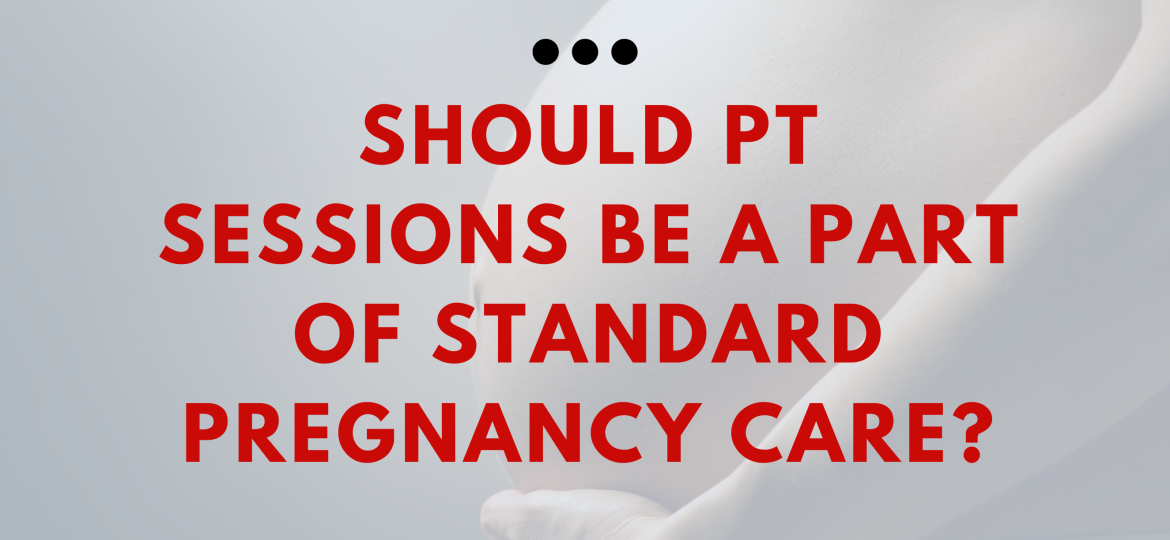
This blog post was written by Alex Spencer a Core Physical Therapy PT specializing in Pregnancy and Postpartum Care.
Back to the question posed in this post: Should PT sessions be e part of standard pregnancy care? YES. Women’s bodies undergo significant changes throughout pregnancy. You’re going to be living in this “new” body for 40 weeks, so why not make that journey as comfortable and enjoyable as we can?
I frequently tell women that as soon as you get that positive test, and take some time to enjoy the news of course, start looking for a pelvic floor physical therapist near you. And if they have their Pregnancy and Postpartum Corrective Exercise Specialist certification, like me, it’s an added bonus. We have additional training in what exercises and movements are safe for women to participate in through each phase of pregnancy.*
Let’s start with the first trimester.
The fatigue can be debilitating for some, and others may feel great. Either of these are completely normal to experience as every pregnancy is different. If you’re somebody who is struggling with intense fatigue, don’t feel guilty if you need to sleep more than focusing on your workouts. You’re growing a human, give yourself some grace. This first trimester is a great time to master the basics anyway, instead of aiming for improved strength and flexibility.
What exactly do I mean by “mastering the basics”?
We need to ensure the individual can obtain a good 360- degree breath. This means that with inhalation, the sides and back of your ribcage expand, the belly and lower back expand, and the pelvic floor muscles relax.
Why is this so important?
As your baby continues to grow, they will impact the amount in which the diaphragm can descend to help you get a good, deep breath. If we train our bodies to utilize the sides of the ribcage and our lower back to breathe, we become more efficient and less likely to experience the shortness of breath that can come as pregnancy progresses.
It also helps to regulate intra-abdominal pressure to mitigate serious prolapse, diastasis recti, and pain throughout pregnancy. The earlier we begin this training, the better. And, not only does breathing help you to have a comfortable pregnancy, it also creates coordination between the diaphragm and pelvic floor that encourages natural core and pelvic floor recovery postpartum.

Education surrounding how to relax the pelvic floor also needs to be provided. Instead of needing a “strong” pelvic floor for labor, we need these muscles to relax and allow baby to progress through the birth canal. Tightness and inability to relax these muscles can lead to a prolonged labor and delivery process.
Finally, we need to be teaching women techniques to utilize so that they are not bearing down with bowel movements, lifting, and other daily activities. Bearing down will create poor intra-abdominal pressure management, leading to increased likelihood of hernias, prolapse, and diastasis recti, both during pregnancy and postpartum.
Now for the second trimester.
This is when women may really start to notice physical changes in their body, specifically rapid growth of their abdomen. This rapid growth can lead to what’s known as diastasis recti, or thinning of the linea alba and separation of our abdominal muscles. The linea alba is a thick piece of connective tissue that connects all abdominal muscles at midline. Stretching of this tissue is completely normal and expected as pregnancy progresses to make room for the growing baby. But individual education needs to be provided to patients so they can avoid the activities that put unnecessary pressure on these tissues, and allow for proper healing after birth.

It has also been shown that relaxin levels peak within the second trimester, around 12-14 weeks to be exact. While this hormone is necessary to provide laxity to joints and tissues that will then allow for passage of baby through the birth canal, it can also create instability and pain through the body. Core stabilization and strength training, to tolerance, are vital to provide extra support to your pelvis as it continues to take the load of your growing child.
Finally, the third trimester.
We want to continue monitoring for signs of poor loading. This may present as abdominal doming or bulging during activities of increased intensity, feelings of heaviness or pressure in the pelvic region, sacroiliac joint pain, and/or pubic symphysis pain. We also want to ensure that mom is maintaining as much ribcage and thoracic mobility as possible, allowing for efficient breathing. Although this does get significantly harder as you near the 40-week mark and baby is pushing up into your diaphragm and ribs. We should focus on activities, exercises, and postures that relax the pelvic floor and open up the pelvic region to prepare for labor and delivery during the last few weeks of the third trimester.
No matter what trimester you are in, I would highly suggest finding a Pregnancy and Postpartum Corrective Exercise Specialist to help you feel the best you possibly can while preparing to bring your little one into the world! Contact us today to get your appointment booked.
